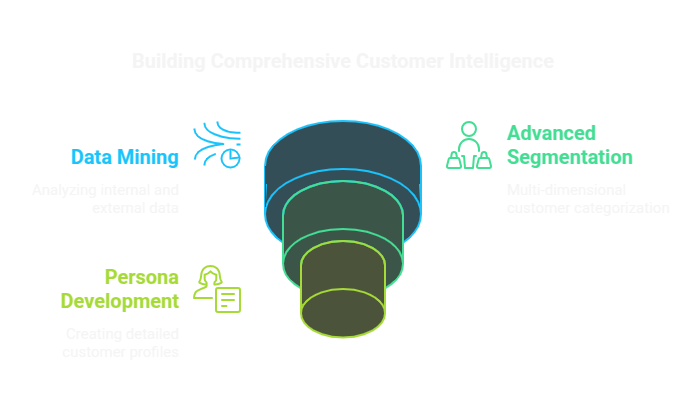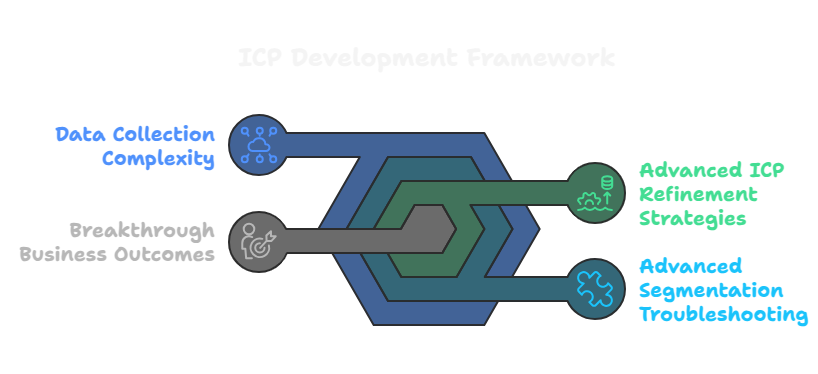Creating ICP: A Definitive Guide to Precision Customer Targeting
This guide will equip market research professionals and go-to-market strategists with a comprehensive framework to decode your customer ecosystem, enabling you to transform broad market assumptions into targeted, high-conversion opportunities. You'll learn how to craft an ICP that doesn't just describe your potential customers, but reveals the hidden patterns of their needs, behaviors, and decision-making triggers.
Whether you're struggling with scattered lead generation, burning through marketing budgets without meaningful returns, or simply seeking a more intelligent approach to customer segmentation, this definitive roadmap will help you align your business strategy with the precise audience that drives real growth. By the end of this guide, you'll have the tools to turn customer insights from guesswork into a data-driven competitive advantage.
Why Every Business Needs a Systematic ICP Creation Tutorial
The difference between successful targeted marketing and wasted resources often comes down to one critical component: a meticulously crafted Ideal Customer Profile (ICP). As businesses navigate increasingly complex market dynamics, the need for a structured, methodical approach to understanding customer segments has never been more urgent.
The Strategic Imperative of Precise Customer Understanding
Market research reveals that companies with well-defined ICPs experience significant performance improvements: 68% higher account win rates, 50% more qualified leads, and a 20% reduction in customer acquisition costs. These aren't just incremental gains—they represent transformative business potential.
For B2B organizations, an ICP transcends traditional demographic segmentation. It's a sophisticated blueprint that captures the nuanced ecosystem of potential customers—their technological landscape, organizational challenges, decision-making dynamics, and strategic priorities.
Critical Obstacles in ICP Development
Most businesses encounter substantial roadblocks when attempting to develop meaningful customer profiles:
- Data Fragmentation: Critical customer insights are scattered across disconnected systems, making holistic analysis challenging.
- Oversimplification: Many organizations rely on superficial characteristics, missing deeper behavioral and strategic indicators.
- Lack of Systematic Approach: Random data collection replaced by strategic, intentional research methodologies.
- Validation Complexity: Transforming raw data into actionable customer narratives requires advanced analytical skills.
These challenges result in marketing strategies that are more like shotgun approaches—loud, expensive, and predominantly ineffective.
A Comprehensive Framework for Precision Targeting
Our step-by-step tutorial addresses these critical challenges by introducing a rigorous, repeatable methodology for ICP development that empowers businesses to:
- Unify Fragmented Data Sources: Create a centralized, comprehensive view of potential customer characteristics
- Deploy Advanced Segmentation Techniques: Move beyond basic demographics to understand intricate customer motivations
- Implement Continuous Refinement Processes: Develop living, evolving customer profiles that adapt with market changes
- Translate Insights into Strategic Action: Convert deep customer understanding into targeted marketing and sales strategies
By providing a structured, repeatable framework, this tutorial bridges the gap between raw data and strategic customer intelligence. It transforms complex market research into clear, actionable insights that drive precise business targeting.
"An Ideal Customer Profile isn't just a document—it's a strategic compass guiding every customer interaction, marketing initiative, and business decision."
Step-by-Step Process for Crafting a Precision Ideal Customer Profile

Step 1: Deep Data Aggregation and Preliminary Research
Transform scattered information into a comprehensive customer intelligence foundation by systematically collecting and analyzing existing data touchpoints.
- Internal Data Mining:
- Analyze CRM records of top-performing accounts
- Review sales team interaction logs
- Extract revenue and engagement metrics from existing customer base
- External Research Channels:
- Leverage industry reports and market research publications
- Conduct competitor customer analysis
- Review LinkedIn company profiles and professional networks
Pro Tip: Use data visualization tools like Tableau or PowerBI to identify hidden patterns and correlations in your collected information.
Recommended Tools:
- Salesforce Analytics
- ZoomInfo
- LinkedIn Sales Navigator
Step 2: Sophisticated Segmentation Architecture
Move beyond basic demographics by developing a multi-dimensional customer segmentation strategy that captures strategic nuances and behavioral indicators.
- Categorize potential customers using advanced dimensions:
- Organizational complexity
- Technology infrastructure
- Growth stage and market positioning
- Strategic priorities and pain points
Pro Tip: Create a scoring matrix that weights each dimensional attribute to generate a comprehensive customer qualification index.
Recommended Tools:
- Lucidchart
- VisualParadigm
- Microsoft Visio
Step 3: Detailed Customer Persona Development
Construct rich, multifaceted personas that reveal the strategic motivations and decision-making dynamics of your ideal customers.
- Design comprehensive persona templates including:
- Professional background and role
- Critical business challenges
- Technology adoption patterns
- Decision-making influence and authority
- Success metrics and professional goals
Pro Tip: Conduct qualitative interviews with existing top-tier customers to validate and enrich your persona development.
Recommended Tools:
- Xtensio User Persona Creator
- UXPressia
- HubSpot Persona Generator
Mastering ICP Development: Troubleshooting and Advanced Strategies

Common Pitfalls in Ideal Customer Profile Creation
Even with a structured approach, businesses frequently encounter critical challenges that can derail their ICP development process. Understanding these potential roadblocks is crucial for maintaining accuracy and strategic alignment.
Data Collection Complexity
- Challenge: Inconsistent or Incomplete Data Sources
- Risk: Fragmenting customer insights across multiple platforms
- Solution:
- Implement a centralized data management system
- Create standardized data collection protocols
- Use integration tools like Zapier to connect disparate data sources
- Challenge: Bias in Data Interpretation
- Risk: Confirmation bias skewing customer profile accuracy
- Solution:
- Engage cross-functional teams in data review
- Utilize external market research to validate internal findings
- Implement blind review processes to minimize subjective interpretations
Advanced Segmentation Troubleshooting
- Challenge: Over-Generalization of Customer Segments
- Risk: Creating broad, ineffective customer profiles
- Solution:
- Develop granular scoring mechanisms
- Create sub-segments within primary customer categories
- Implement dynamic segmentation that adapts to market changes
- Challenge: Insufficient Validation Mechanisms
- Risk: Unverified customer assumptions
- Solution:
- Conduct regular customer interviews
- Develop feedback loops with sales and customer success teams
- Use predictive analytics to test profile accuracy
Advanced ICP Refinement Strategies
- Continuous Profile Evolution
- Schedule quarterly ICP review and update processes
- Develop real-time tracking mechanisms for customer behavior shifts
- Create adaptive machine learning models for ongoing segmentation
Transforming Customer Intelligence into Strategic Advantage
By meticulously implementing this ICP development framework, B2B professionals unlock a powerful blueprint for precision marketing and targeted business growth. The journey from scattered data to strategic customer insights represents a fundamental transformation in how organizations approach market engagement.
Breakthrough Business Outcomes
- Hyper-Targeted Marketing Precision: Eliminate wasteful spending by focusing resources on highest-potential customer segments
- Accelerated Sales Conversion Rates: Develop messaging and engagement strategies that resonate directly with ideal customer motivations
- Strategic Resource Optimization: Align organizational capabilities with most promising market opportunities
- Predictive Market Positioning: Build adaptive strategies that anticipate customer evolution and emerging market dynamics
Measuring ICP Implementation Success
- Customer Acquisition Cost (CAC) Reduction: Track percentage decrease in marketing and sales expenditure per acquired customer
- Qualified Lead Conversion Rate: Monitor improvement in lead-to-customer conversion percentages
- Account Win Rate: Measure increases in successful customer acquisition within targeted segments
- Customer Lifetime Value (CLV) Enhancement: Evaluate growth in long-term customer revenue potential
"Precision in customer understanding isn't a luxury—it's the fundamental differentiator between businesses that merely survive and those that strategically thrive."
Conclusion: Mastering Your Ideal Customer Profile
Creating an effective Ideal Customer Profile (ICP) is an iterative and dynamic process that requires continuous refinement and strategic insight. By systematically collecting and analyzing data across demographic, firmographic, technographic, and behavioral dimensions, market research professionals can develop a nuanced understanding of their most valuable customer segments. The key to success lies not just in generating an initial profile, but in maintaining a flexible approach that adapts to evolving market conditions, emerging technologies, and shifting customer preferences. Regular validation through customer feedback, sales team insights, and performance metrics ensures that your ICP remains a powerful strategic tool for precision targeting, resource allocation, and ultimately, driving sustainable business growth. Remember that an ICP is more than a static document—it's a living framework that reflects the complex, interconnected nature of modern B2B and B2C markets.
